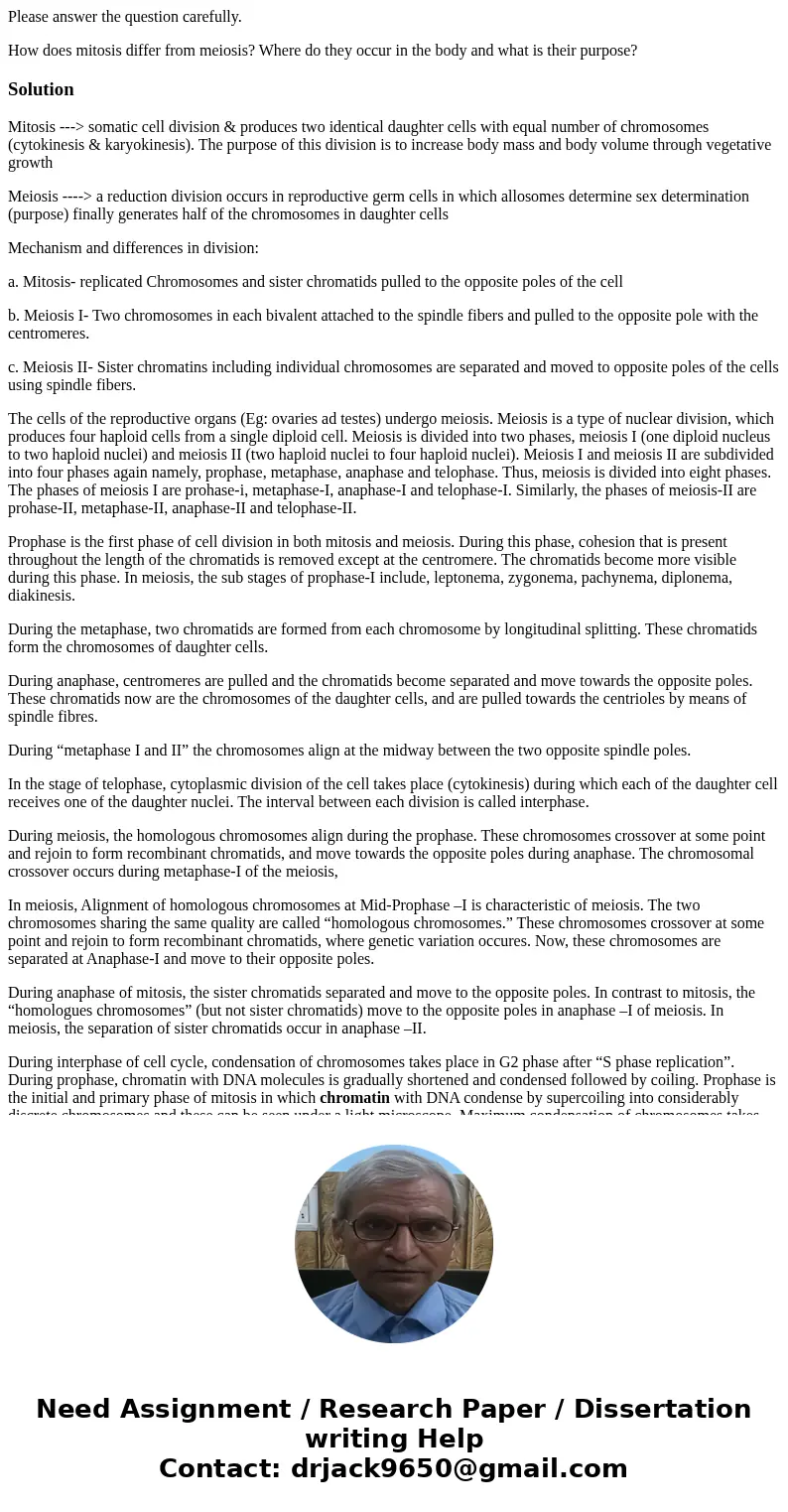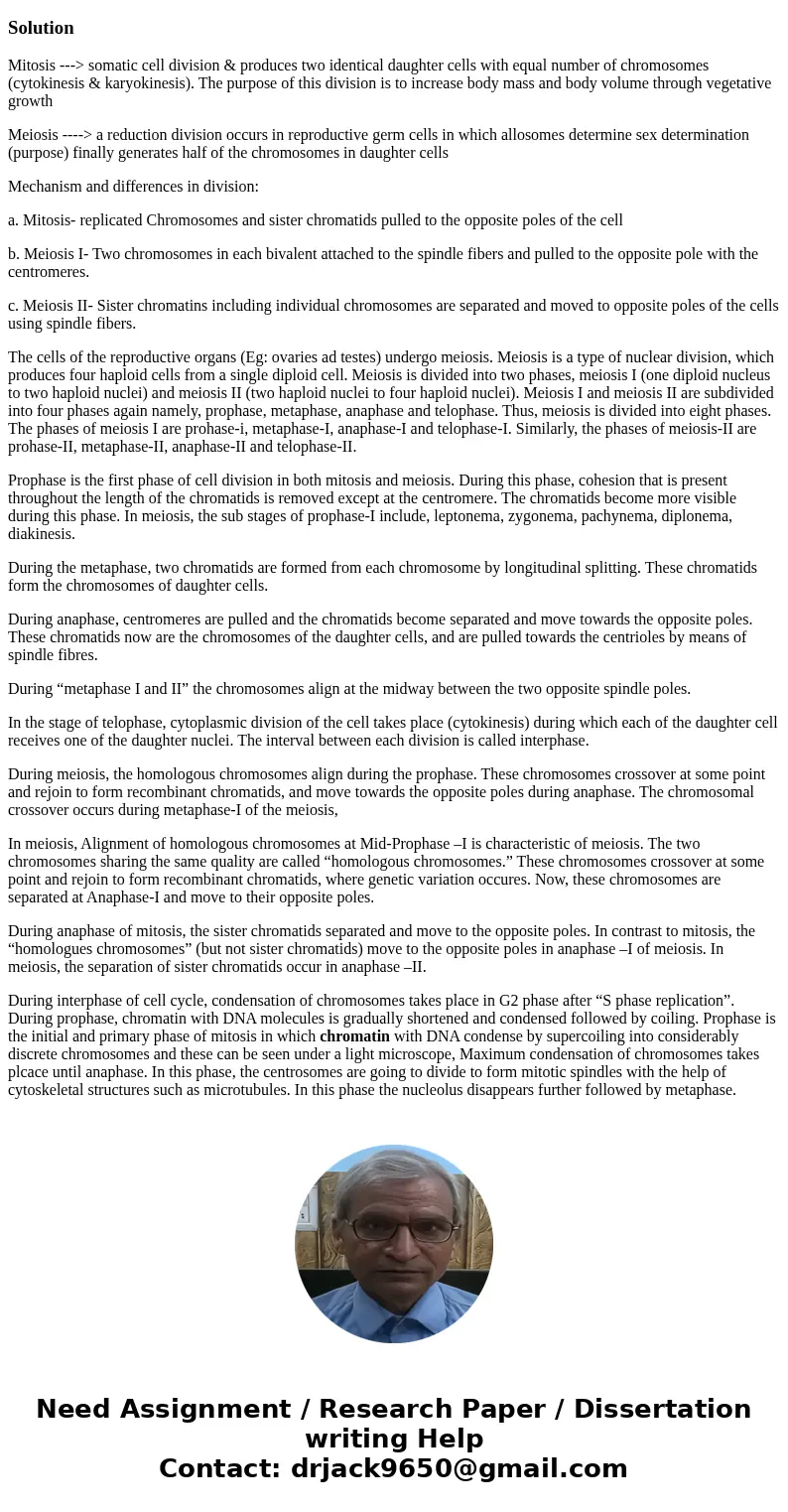Please answer the question carefully How does mitosis differ
Please answer the question carefully.
How does mitosis differ from meiosis? Where do they occur in the body and what is their purpose?
Solution
Mitosis ---> somatic cell division & produces two identical daughter cells with equal number of chromosomes (cytokinesis & karyokinesis). The purpose of this division is to increase body mass and body volume through vegetative growth
Meiosis ----> a reduction division occurs in reproductive germ cells in which allosomes determine sex determination (purpose) finally generates half of the chromosomes in daughter cells
Mechanism and differences in division:
a. Mitosis- replicated Chromosomes and sister chromatids pulled to the opposite poles of the cell
b. Meiosis I- Two chromosomes in each bivalent attached to the spindle fibers and pulled to the opposite pole with the centromeres.
c. Meiosis II- Sister chromatins including individual chromosomes are separated and moved to opposite poles of the cells using spindle fibers.
The cells of the reproductive organs (Eg: ovaries ad testes) undergo meiosis. Meiosis is a type of nuclear division, which produces four haploid cells from a single diploid cell. Meiosis is divided into two phases, meiosis I (one diploid nucleus to two haploid nuclei) and meiosis II (two haploid nuclei to four haploid nuclei). Meiosis I and meiosis II are subdivided into four phases again namely, prophase, metaphase, anaphase and telophase. Thus, meiosis is divided into eight phases. The phases of meiosis I are prohase-i, metaphase-I, anaphase-I and telophase-I. Similarly, the phases of meiosis-II are prohase-II, metaphase-II, anaphase-II and telophase-II.
Prophase is the first phase of cell division in both mitosis and meiosis. During this phase, cohesion that is present throughout the length of the chromatids is removed except at the centromere. The chromatids become more visible during this phase. In meiosis, the sub stages of prophase-I include, leptonema, zygonema, pachynema, diplonema, diakinesis.
During the metaphase, two chromatids are formed from each chromosome by longitudinal splitting. These chromatids form the chromosomes of daughter cells.
During anaphase, centromeres are pulled and the chromatids become separated and move towards the opposite poles. These chromatids now are the chromosomes of the daughter cells, and are pulled towards the centrioles by means of spindle fibres.
During “metaphase I and II” the chromosomes align at the midway between the two opposite spindle poles.
In the stage of telophase, cytoplasmic division of the cell takes place (cytokinesis) during which each of the daughter cell receives one of the daughter nuclei. The interval between each division is called interphase.
During meiosis, the homologous chromosomes align during the prophase. These chromosomes crossover at some point and rejoin to form recombinant chromatids, and move towards the opposite poles during anaphase. The chromosomal crossover occurs during metaphase-I of the meiosis,
In meiosis, Alignment of homologous chromosomes at Mid-Prophase –I is characteristic of meiosis. The two chromosomes sharing the same quality are called “homologous chromosomes.” These chromosomes crossover at some point and rejoin to form recombinant chromatids, where genetic variation occures. Now, these chromosomes are separated at Anaphase-I and move to their opposite poles.
During anaphase of mitosis, the sister chromatids separated and move to the opposite poles. In contrast to mitosis, the “homologues chromosomes” (but not sister chromatids) move to the opposite poles in anaphase –I of meiosis. In meiosis, the separation of sister chromatids occur in anaphase –II.
During interphase of cell cycle, condensation of chromosomes takes place in G2 phase after “S phase replication”. During prophase, chromatin with DNA molecules is gradually shortened and condensed followed by coiling. Prophase is the initial and primary phase of mitosis in which chromatin with DNA condense by supercoiling into considerably discrete chromosomes and these can be seen under a light microscope, Maximum condensation of chromosomes takes plcace until anaphase. In this phase, the centrosomes are going to divide to form mitotic spindles with the help of cytoskeletal structures such as microtubules. In this phase the nucleolus disappears further followed by metaphase.


 Homework Sourse
Homework Sourse